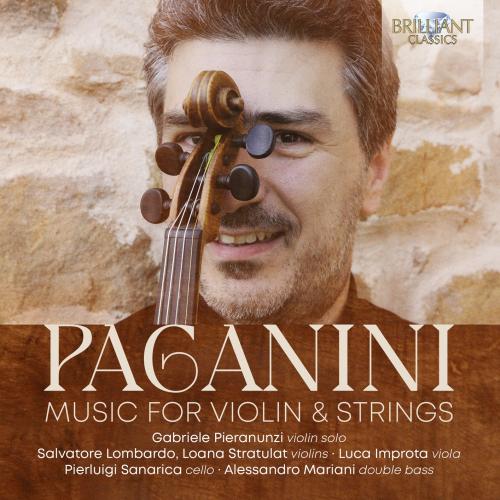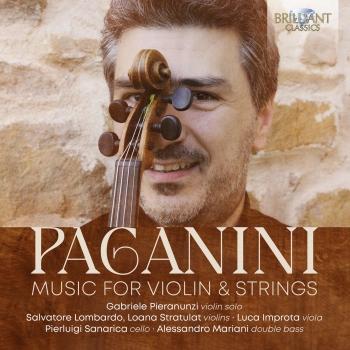
Paganini: Music for Violin & Strings Gabriele Pieranunzi
Album info
Album-Release:
2023
HRA-Release:
26.09.2023
Label: Brilliant Classics
Genre: Classical
Subgenre: Chamber Music
Artist: Gabriele Pieranunzi
Composer: Niccolo Paganini (1782-1840)
Album including Album cover Booklet (PDF)
- Nicolò Paganini (1782 - 1840: Violin Concerto No. 2, MS 48:
- 1 Paganini: Violin Concerto No. 2, MS 48: III. Rondò 'la campanella' 06:45
- Sonata 'a preghiera', MS 23 (Moses Fantasy):
- 2 Paganini: Sonata 'a preghiera', MS 23 (Moses Fantasy) 09:33
- Cantabile, MS 109:
- 3 Paganini: Cantabile, MS 109 05:26
- Le streghe, MS 19 (Witches' Dance):
- 4 Paganini: Le streghe, MS 19 (Witches' Dance) 12:17
- Sonata No. 6 in E Minor, MS 27/6:
- 5 Paganini: Sonata No. 6 in E Minor, MS 27/6: I. Andante innocentemente 03:39
- 6 Paganini: Sonata No. 6 in E Minor, MS 27/6: II. Allegro vivo e con spirito, minore 01:34
- Sonata No. 3 in D Major, MS 27/3:
- 7 Paganini: Sonata No. 3 in D Major, MS 27/3: I. Andante sostenuto - II. Rondo. Molto allegro 04:47
- Duetto concertante No. 1 in E-Flat Major, MS 107/1:
- 8 Paganini: Duetto concertante No. 1 in E-Flat Major, MS 107/1: I. Allegro 06:26
- 9 Paganini: Duetto concertante No. 1 in E-Flat Major, MS 107/1: I. Rondò. Allegretto 04:29
- Duetto concertante No. 2 in G Major, MS 107/2:
- 10 Paganini: Duetto concertante No. 2 in G Major, MS 107/2: I. Allegro 08:08
- 11 Paganini: Duetto concertante No. 2 in G Major, MS 107/2: II. Rondò 02:55
- Duetto concertante No. 3 in A Major, MS 107/3:
- 12 Paganini: Duetto concertante No. 3 in A Major, MS 107/3: I. Allegro 07:01
- 13 Paganini: Duetto concertante No. 3 in A Major, MS 107/3: II. Polonese. Andante con brio 02:54
Info for Paganini: Music for Violin & Strings
Paganini was the first great ‘star’ of instrumental music, the precursor of the rock stars of today, able to induce collective hysteria as well as to dictate fashion and to influence the behaviour of entire generations. He did this by transforming the violin into an orchestra of multiple voices and timbral experimentation, in other words, stretching the very limits of what a single instrument could do.
This programme is particularly interesting, both for the quality of the performances as well as the new chamber-string versions created by Francesco Fiore and Salvatore Lombardo. It also juxtaposes extremely popular Paganini works alongside compositions not very often heard in the concert hall but which help flesh out our understanding of the artistry of a composer too often misjudged as merely an acrobat of the violin.
In four of Paganini’s best-known compositions – the ‘Campanella’ (Bell) movement from the Violin Concerto No.2, the Moses Fantasy, the Witches’ Dance and the Cantabile – the solo violin is here accompanied by a string quintet.
In the first three, the string quintet stands in for the orchestra with a consequent lightening of accompaniment. In the Cantabile, the original of which was for violin and piano (Paganini’s only piece to be accompanied by keyboard rather than guitar), the ‘heavier’ quintet accompaniment still manages to retain a discreet sense of enjoyable sophistication The next two works, Nos. 6 and 3 of the 6 Sonatas Op.3 for violin and guitar, are presented here in transcriptions for two or three violins. These two sonatas, written in the salon style typical of the age, delight the listener with the conversational nature of the violin writing.
Finally come three compositions in their original versions, providing an excursion into a lesser-known, but still very interesting, area of Paganini’s chamber output. The three Duetti concertanti for violin and cello were written for the enjoyment of amateur players, each comprising two movements.
Gabriele Pieranunzi, violin solo
Salvatore Lombardo, violin
Loana Stratulat, violin
Luca Improta, viola
Pierluigi Sanarica, cello
Allessandro Mariani, double bass
Gabriele Pieranunzi
For the precocious talent and the uncommon natural skills, Gabriele Pieranunzi has imposed soon at the attention of the public and musical critics as one of the most important italian violinist of his generation.
Between the numerous statements in international competition which caracterised he’s entrance on the musical stage stands out the two awards at “N.Paganini” of Genua (1988, 1990), together with other important awards at very prestigious international competitions: “Tibor Varga” (Sion), “L.Spohr” (Fribourg), “R.Romanini” (Brescia), “G.B.Viotti” (Vercelli), “R.Lipizer” (Gorizia) and “Biennale of Vittorio Veneto”.
Graduating at 16 guided by Arrigo Pelliccia, he was later improved his studies with F.Gulli and St.Gheorghiu.
During his brilliant career as soloist, he performed with great conductors like Aldo Ceccato, Alun Francis, Lu Jia, Jeffrey Tate, Piero Bellugi, Matthias Bamert, U.Benedetti Michelangeli, Anton Nanut, Julian Kovatchev, Nicolas Cleobury, Gianandrea Noseda and collaborated, on the chamber music’s field with Boris Belkin, Bruno Canino, Alfons Kontarsky, Rocco Filippini, Franco Petracchi, Nelson Goerner, Alain Meunier, Laura De Fusco, Rainer Kussmaul, Alexander Ivashkyn.
Invited many times by the Municipality of Genua to play on the famous Guarneri del Gesù “Il Cannone” – violin belonged to N.Paganini, he is regular guest of the most important italian musical istitutions like Accademia Nazionale of S.Cecilia of Rome, Accademia Chigiana of Siena, Teatro Regio of Turin, Teatro Carlo Felice of Genova, Orchestra Sinfonica “G.Verdi” of Milan, Teatro Comunale of Bologna, Teatro S.Carlo of Naples (where performed, under the musical conduction of J.Tate, K.Weill’s Concerto for violin and winds and Tzigane by Ravel), Festival dei Due Mondi of Spoleto, Settimane Internazionali di Musica da Camera at Villa Pignatelli of Naples and Settimane Musicali of Stresa, where executed the complete Sonatas for piano and violin by Beethoven. He is also a regular guest of various important musical istitutions around the world: Herculeesaal of Monaco di Baviera, Baden Baden Philharmonie, Rtsi of Lugano, Festival Bemus of Belgrado, Filarmonica G.Enescu of Bucarest, Wigmore Hall of London (Canino and Friends), City of Birmingham Symphony Orchestra (Paganini Concerto no. 2 “The bell”, dir. G.Noseda), Bournemouth Symphony Orchestra (Paganini Concerto no. 1), Franz Liszt Chamber Orchestra of Budapest, Malmoe Symphony Orchestra (Beethoven Concerto for violin, dir. G.Noseda), Opera City Hall of Tokyo.
In 2002, he was the protagonist of a tour in South America, wich culminated with the concert at “Teatro Coliseum” in Buenos Aires.
From 2004, after the assignment given to well-known, is the first violin of the orchestra of the Theatre of S.Carlo of Naples.
Very refined in the interpretation of the chamber music repertory, G.Pieranunzi has released the following CD:
The Quartets for piano and stringsby Fauré, with Maurizio Baglini (piano), attached to the “Amadeus” Italian music magazine, February 2006;
The Quintets for clarinet and stringsby Mozart and Brahms, with A.Carbonare (clarinet), attached to the “Amadeus” Magazine, April 2007;
The first volume of the Quartets for piano and stringsby Mendelssohn, with Roberto Prosseda (Decca-Universal), December 2012.
Recently he recorded for “Concerto Classics” label a CD with K.Weill’s Concerto for violin and winds, together with the S.Carlo Theatre of Naples orchestra, conducted by Jeffrey Tate, L’Histoire du Soldat by Stravinsky and Suite Concertante by Milhaud, for violin, clarinet and piano, with A. Carbonare (clarinet) and E. Pieranunzi (piano).
The Birmingham post wrote: “Gabriele Pieranunzi, the sweetest – toned violinist you could imagine…a rewarding and immaculately contoured reading nonetheless”.
The Skanska Dagbladet wrote: “Was many years that the audience in Malmoe didn’t listen a so perfect performance”.
Booklet for Paganini: Music for Violin & Strings











